|
|
 |
 |
 |
 |
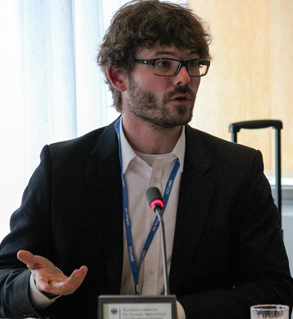 |
| Joeri Rogelj, ETH, reminded that technological advances “won’t fall out of the sky,” they require policy decisions and investments in research. |
|
 |
 |
 |
 |
|
|
|
The panel presented models on the conditions, risks and costs of emission trajectories associated with 2020 pledges. Niklas Höhne, ECOFYS, provided context by explaining that there is an emissions gap between current pledges and least-cost pathways to meet the 2°C target. He stated the models presented in this panel explore whether emissions can first rise, according to the pledges, then fall to meet the target.
Michel den Elzen, Environmental Assessment Agency, the Netherlands, reported that if all countries implement their ambitious, conditional pledges, then the target is possible, but requires: higher mitigation costs after 2020; long-term dependence on mitigation technologies; and reduced flexibility. He added new emission projections from developing countries show that it would be more difficult to meet the target.
Joeri Rogelj, Swiss Federal Institute of Technology Zurich (ETH), called reaching the target from 2020 pledges a “risky endeavor.” He reported that, allowing for nuclear phase-out, with full technology deployment the target is feasible. However, he said other technologies, such as carbon capture and storage, are necessary. Rogelj stated that without technological breakthroughs, there is a higher risk of exceeding the target.
Gunnar Luderer, PIK, used feasibility frontiers to assess what temperature increases are possible under various mitigation and cost scenarios. He reported that immediate action and crucial technologies are necessary to reach 2°C, but delaying until 2020 makes the target more costly and reliant on technologies that are not yet market-ready.
Niklas Höhne, ECOFYS, summarized the presentations, stating the common conclusion is that scenarios exist showing current pledges could meet the 2°C target, but with the following conditions: reliance on all mitigation options; globally negative emissions; low flexibility; and high mitigation costs.
Discussions addressed: adaptation costs; reference scenarios; feasibility of deploying all technologies; risk management; and differences between developed and developing countries. |
Hiroshi Minami, Ministry of Foreign Affairs, Japan, highlighted two Japanese initiatives, Japan’s Vision and Actions Toward Low-Carbon Growth and a Climate-Resilient World and the East Asia Low Carbon Growth Partnership. He noted the need to achieve low-carbon growth by mobilizing technology, markets and finance. On the Partnership, he underscored the importance of cooperation to achieve low-carbon growth through bilateral and regional initiatives.
Farhan Helmy, National Council on Climate Change, Indonesia, said key elements of their Low-Carbon Growth Strategy (LCGS) are: sustainable economic development; sector specific abatement; district-level abatement; and implementation. He highlighted the importance of national- and regional-level networks to share ideas, experiences and explore potential collaboration. He said cooperation should: encourage strategic integrative research; use all related forums; develop policy, information exchange and databases; establish expert groups; and link strategies to implementation.
Yamil Bonduki, UNDP, discussed building capacity to access climate finance, noting the complexity of the funders and sources of finance. He said challenges include: limited national capacities; the need to catalyze private finance; and lack of alignment between climate and development policy. He said UNDP is encouraging countries to develop Green Low-Emission Climate-Resilient Development Strategies as a first step to assess needs and priorities, and identify barriers to investment and potential sources of funding.
Yuji Mizuno, Ministry of Environment, Japan, presented a new initiative to establish the Bilateral-Offset Credit Mechanism (BOCM), which aims to provide low-carbon technologies, products and services to developing countries, in return for carbon credits. He said the rollout of the mechanism has included feasibility studies, and measuring, reporting and verification (MRV) model projects, which begin this fiscal year. The BOCM will start operating during the next fiscal year.
Tomoko Ishikawa, Institute for Global Environmental Strategies (IGES) highlighted various regional networks including the: International Low-Carbon Society Research Network (LCS-RNet); Low-Carbon Research Network (LoCARNet); and the East Asia Knowledge Platform for Low-Carbon Growth, which is being established.
Discussions highlighted: mainstreaming low-carbon strategies into planning processes; types of projects run by UNDP; and building capacity for MRV and implementing feasibility studies for the BOCM. |
Moderator Juan Carlos Jintiach, COICA, invited panelists to discuss the “Indigenous REDD+” Initiative. UNFCCC Executive Secretary Christiana Figueres underscored the value of traditional knowledge for REDD+, noting hard work on this issue. She supported the role of indigenous peoples providing monitoring on the ground. Figueres admired the holistic perspective provided, saying that although complicated, it is necessary.
Roberto Espinoza Llano, COICA, presented technical aspects of Indigenous REDD+, underscoring the profound unity between nature, community and culture means carbon cannot be separated. In order to address challenges, such as the gap between theory and practice, and the increase of carbon markets on titled lands, he summarized that the Initiative calls for: holistic management of indigenous territories; reduction of the global ecological footprint; and reduction and control of deforestation and degradation drivers.
Victoria Tauli-Corpuz, Tebtebba, acknowledged the value of the Initiative to current negotiations, indicating implementing agreements made in Cancun and Durban on safeguards, along with monitoring, is the way forward.
Keith Anderson, Federal Office for the Environment, Switzerland, said the Initiative has elements broader than emissions reductions, suggesting that implementation challenges can be addressed through safeguards, securing private sector financing, and governance.
Eirik Brun Sørlie, Ministry of the Environment, Norway, urged COICA to continue engagement on the national level and with other organizations to provide the valuable voice of the indigenous peoples.
John Verdieck, State Department, US, underscored the importance of visibility, openness and transparency, drawing attention to the recent US submission on safeguards.
Thomas Brose, Climate Alliance, said work should start under the existing legal framework, while raising challenges, including permanence of carbon stocks and services, and financing.
Gerald Steindlegger, WWF, welcomed the Initiative, pointing out that international drivers play a large role.
Discussion topics included: historic credit for conservation of forests by indigenous peoples; corruption; and international drivers. |
 |
 |
 |
 |
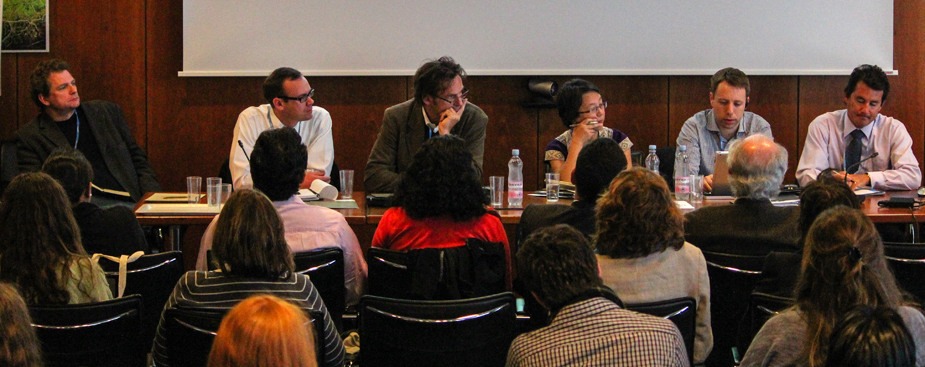 |
| L-R: Thomas Brose, Climate Alliance; John Verdieck, State Department, US; Gerald Steindlegger, WWF; Victoria Tauli-Corpuz, Tebtebba; Eirik Brun Sørlie, Ministry of the Environment, Norway; and Keith Anderson, Federal Office for the Environment, Switzerland. |
|
 |
 |
 |
 |
|
|
 |
 |
 |
 |
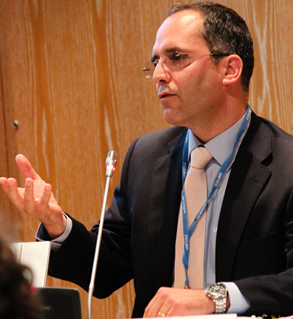 |
| Federico Lopez-Casero, IGES, described why poor governance is a driver of forest loss. |
|
 |
 |
 |
 |
|
Rosalind Reeve, Ateneo School of Government, introduced a panel on the drivers of deforestation and forest degradation in relation to consumption, animal agriculture, policy harmonization and governance standards.
Peg Putt, Global Witness, suggested a framework for addressing demand-side drivers, stressing global demand for commodities like food, furniture and energy is the main driver of deforestation and forest degradation. Putt argued that curbing drivers are the responsibility of developed countries and consumers, concluding that restricting responsibility to developing countries for drivers that are out of their control is fundamentally unfair.
Geoff Evans, Humane Society International, expressed concern about perverse outcomes from cattle ranching intensification projects (CRIPS), aimed to reduce deforestation by increasing the stocking density of livestock. Evans said that although CRIPS may deliver some benefits, including the reduction of methane emissions and increased production, they also pose problems, including incentives for further deforestation, adverse effects on animal welfare and additional water pollution.
Nils Hermann Ranum, Rainforest Foundation, Norway, referenced “Beauty and the Beast,” a report contrasting Norway’s US$ 1 billion Climate and Forest Initiative with its even larger Government Pension Fund Global (GPFG) investments in sectors known to contribute to tropical deforestation. Ranum argued that this lack of coherence in government policies undermines Norway’s efficient use of economic resources, REDD+ initiatives and compliance with the Cancun Agreements.
Federico Lopez-Casero, IGES, described how governance standards can contribute to fair and effective REDD+ projects by increasing participation, accountability and transparency based on locally-specific criteria.
Participants discussed the need for: proactive investments in forest-friendly companies; ethical investment guidelines, and governance standards in place prior to project proposal. Lars Hanssen, Ministry of Finance, Norway, noted that the Norwegian parliament has raised questions and suggestions similar to those raised in the “Beauty and the Beast” report, saying the Ministry of Finance is investigating the issue and that GPFG has a strategy for sustainable investments in place. |
|
|
 |
 |
 |
 |
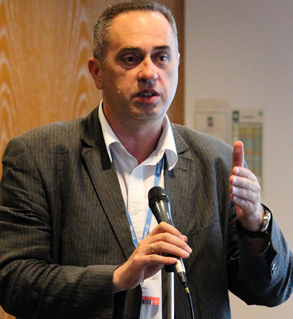 |
| Participant Andro Drecun, Ministry of Sustainable Development and Tourism, Montenegro, shared his perspective that eight years of negotiations may seem long, but that it is better to arrive at a sound decision than a fast one. |
|
 |
 |
 |
 |
|
Moderator Francesco Martone, Forest Peoples Programme, framed presentations on whether the Durban Platform will dilute or strengthen commitments, highlighting equity and the fate of existing commitments and protocols. He encouraged consideration of the global political landscape and how the shifting balances of power and wealth influence negotiations. He spoke on the significant role of indigenous peoples in providing practices and modalities to address adaptation and mitigation at the local and national levels.
Victoria Tauli-Corpuz, Tebtebba, commented on the shift in countries responsible for the highest emissions, indicating the need for new approaches to address mitigation. She highlighted challenges facing the working group on the Durban Platform to reach an agreed outcome with legal force applicable to all parties by 2015 with entry into force by 2020. She cautioned that this time span could promote business-as-usual, resulting in increased temperatures, continued marginalization, and increased future impacts from climate change. She stressed the need for the outcome to operationalize equity for indigenous peoples by embedding and reaffirming the principles of the UNFCCC. On ways forward, she noted the importance of adaptation, safeguards, enforcement and compliance, as well as linking the framework to the Convention on Biological Diversity (CBD).
Stanley Kimaren, Indigenous Livelihoods Enhancement Partners (ILEPA), stated that delayed and indefinite actions threaten past gains, as well as future solutions. He called for human rights to be integrated into the climate change regime, recognizing the value of indigenous knowledge, customary institutions and governance. He spoke about social, environmental and economic safeguards to recognize the value and vulnerability of indigenous peoples. He concluded that self-determination remains the way forward and encouraged indigenous peoples to build networks and solidarity on the national, regional and global levels.
Following presentations, the group explored: the appropriate amount of time to deliver the Durban Platform; how to build cultural sensitivity to sustaining natural resources for future generations; the role of Indigeneous Peoples globally; and the need to continue to push forward.
. |
|
|
 |
 |
 |
 |
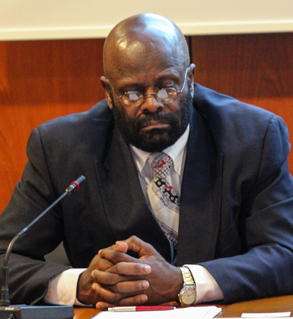 |
| Tyrone Applewhaite, Ministry of Health, Barbados, moderated the session, lauding outcomes of the joint GEF/UNDP/WHO project. |
|
 |
 |
 |
 |
|
The panel shared countries’ experiences in the Global Project of Piloting Climate Change Adaptation to Protect Human Health Spaces. Diarmid Campbell-Lendrum, WHO, stated the Project is a learning experience for adaptation to a broad range of health impacts of climate change and reported emerging convergence regarding measures to strengthen health resilience to climate change.
Bonizella Biagini, Global Environment Facility (GEF), described funding for adaptation in the health sector under the UNFCCC, including the Least Developed Country Fund (LDCF) and Special Climate Change Fund (SCCF), noting US$ 780 million available.
Bettina Menne, WHO-Europe, presented activities of the Protecting Health from Climate Change project undertaken after consultations to identify countries’ vulnerability and needs in Eastern European project countries.
Jin Yinlong, Center for Disease Control, China, and Sergey Myagkov, Centre of Hydrometeorological Services, Uzbekistan, described early warning models developed to disseminate information on health risks related to higher temperatures.
Zam Kinley, Ministry of Health, Bhutan, shared capacity building needs including national expertise and epidemiological monitoring capacity. She reported on training of health professionals, village health workers and teachers on climate-related health effects.
Salah Al-Hyari, Ministry of Health, Jordan, and Kempha Ombacho, Ministry of Public Health and Sanitation, Kenya, outlined the inter-Ministerial efforts to address health impacts of water scarcity and vector-borne diseases.
Kamal Khatri, WHO-South Pacific, and Winfred Greaves, Ministry of Public Health, Barbados, discussed projects to address the health impacts of water stress. Khatri said next steps in Fiji's project are developing early warning systems, strengthening health information systems and undertaking community health adaptation activities. Greaves highlighted use of rainwater catchments and wastewater treatment as project examples in Barbados. |
 |
 |
 |
 |
Daily web coverage
(click on the following links to see our daily web pages)
|
|
|
|
|
 |
 |
 |
 |
 |
 |
 |
 |
 E-mail the
Digital Editor
should you have any questions regarding the content of this page
E-mail the
Digital Editor
should you have any questions regarding the content of this page |
 |
 |
 |
 |
|
|
|
|